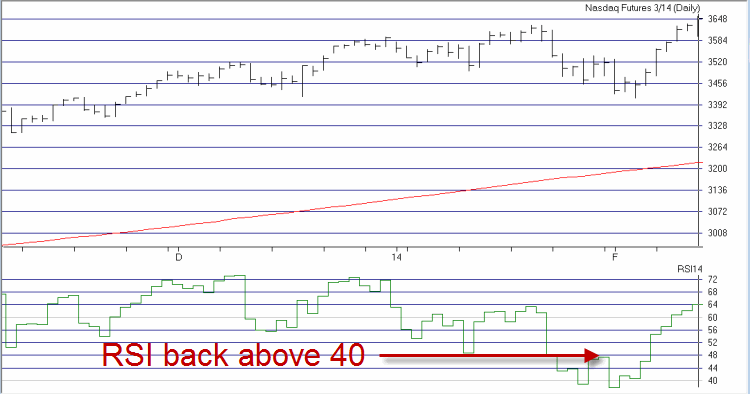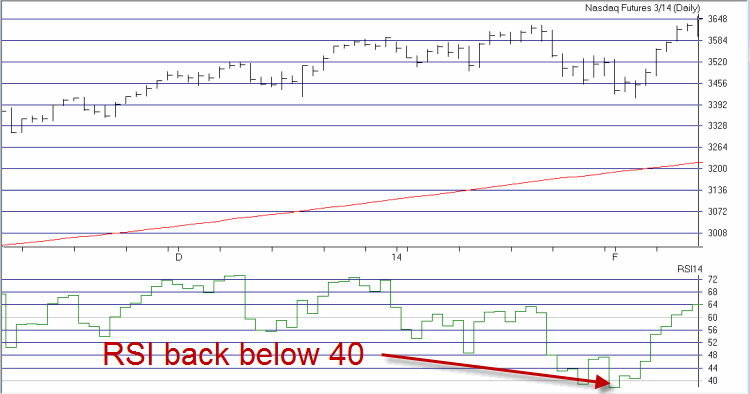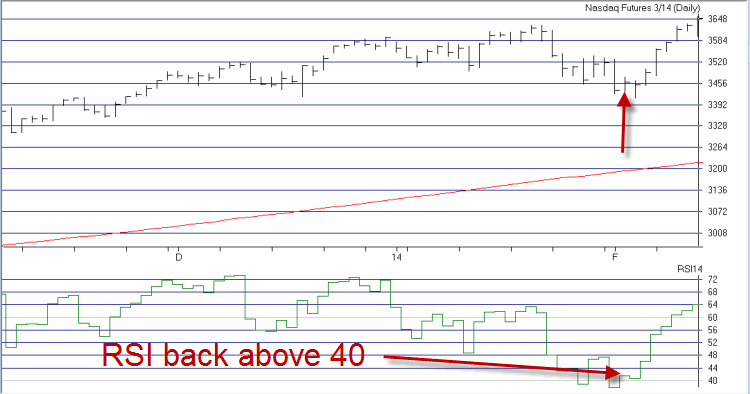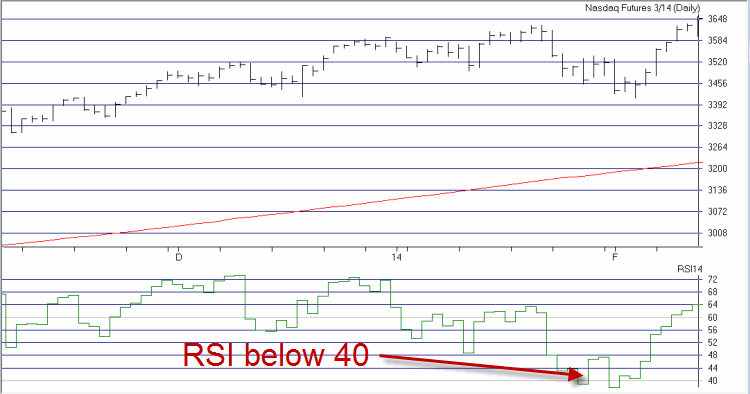My definition of the phrase “trading setup” is something along the lines of “a sequence or series of events which may signal a potentially profitable trading opportunity (or not).”
OK, perhaps that is not the most inspiring definition, but at least it is factually accurate.
In any event, let’s look at an example “setup” using the way old fashioned Welles Wilder 14-day RSI.
(My recent MTA webinar: “Finding Exceptional Opportunities” http://go.mta.org/watch112013)
(My recent video: “How to Find Longer-Term Bull Call Spreads” http://jayonthemarkets.com/?p=303)
Long Entry Rules
1. A security falls, sending its RSI below 40. This alerts you to potential bottoming action.
2. Next, within say the next 20 trading days, the security rallies, the RSI rises back above 40 and then the security declines again. Whether the security makes a new low or not is not relevant.
3. During this second decline the RSI must once again fall from above 40 to below 40.
4. Once the RSI moves back above 40 again, look to buy when the security makes a high that is higher than the high of the previous trading day.
Short Entry Rules
1. A security rises, sending its RSI above 60. This alerts you to potential topping action.
2. Next, within say the next 20 trading days, the security falls, the RSI declines back below 60 and then the security rises again. Whether the security makes a new high or not is not relevant.
3. During this second advance the RSI must once again rise from below 60 to above 60.
4. Once the RSI moves back below 60 again, look to sell short when the security makes a low that is lower than the low of the previous trading day.
An Important Note: For the record, a useful filter is to only consider Long Entry Rules when the security closes above it’s 250-day moving average and Short Entry Rules when the security closes below it’s 250-day moving average (i.e., trade pullbacks within a larger trend).
The advantage of not using a moving average price filter is that it can allow you at times to get in very close to an actual top or bottom. The disadvantage of not using the filter is that in a sustained price move you can end up trying to “catch a falling safe” or “stop a runaway train.” So a little bit of experimentation and “eyes wide open” analysis is required before actual implementation.
Another Important Note: There are a lot of important related topics that are not covered in this piece that would need to be addressed before anyone actually tried to make a trade sing the information contained here. For example:
-Position sizing (i.e., Money Management): What % of capital would you commit to a single trade? All trades combined?
-Risk Control (i.e., Risk Management): What % of capital commited to a trade are you willing to risk? Where will you place a stop-loss? Etc.
So remember, this is just an example of a “setup”, not an actual fully functioning trading system or method.
Example
CYA out of the way, let’s highlight a recent example using Nasdaq eMini Futures. In Figures 1 through 5 below you can see the sequence I described above:
Figure 1 – RSI drops below 40
Figure 2 – RSI rises back above 40
Figure 3 – RSI falls back below 40 a second time
Figure 4 – RSI rises back above 40 again
Figure 5 – NQ breaks above its previous day’s high and a rally ensures.
 Figure 2 – RSI rises back above 40
Figure 2 – RSI rises back above 40
 Figure 3 – RSI falls back below 40 a second time
Figure 3 – RSI falls back below 40 a second time
 Figure 4 – RSI rises back above 40 again
Figure 4 – RSI rises back above 40 again
 Figure 5 – NQ breaks above its previous day’s high and a 150 point rally ensures.
Figure 5 – NQ breaks above its previous day’s high and a 150 point rally ensures.
So in a perfect world that’s the way it works. Some recent example of setups for the inquisitive to review are JPM, MSFT, YHOO and the Euro (futures symbol EC) on the upside and TLT, IBM and CSCO and Japanese Yen (futures symbol Y) on the downside.
Summary
Can it really be this simple? Well, sometimes, yah. But remember, a trading setup is not the same thing as a trading system. A setup simply alerts you to a potential opportunity. Actual entries, exits, capital allocation, etc. must be addressed in advance.
Still, the real point of this piece is simply to highlight how sometimes good old-fashioned setups can still be extremely useful.
Jay Kaeppel



Thanks a lot for sharing this publicly, it helped me a lot after reading this now i can easily differentiate between trading setup and trading system.